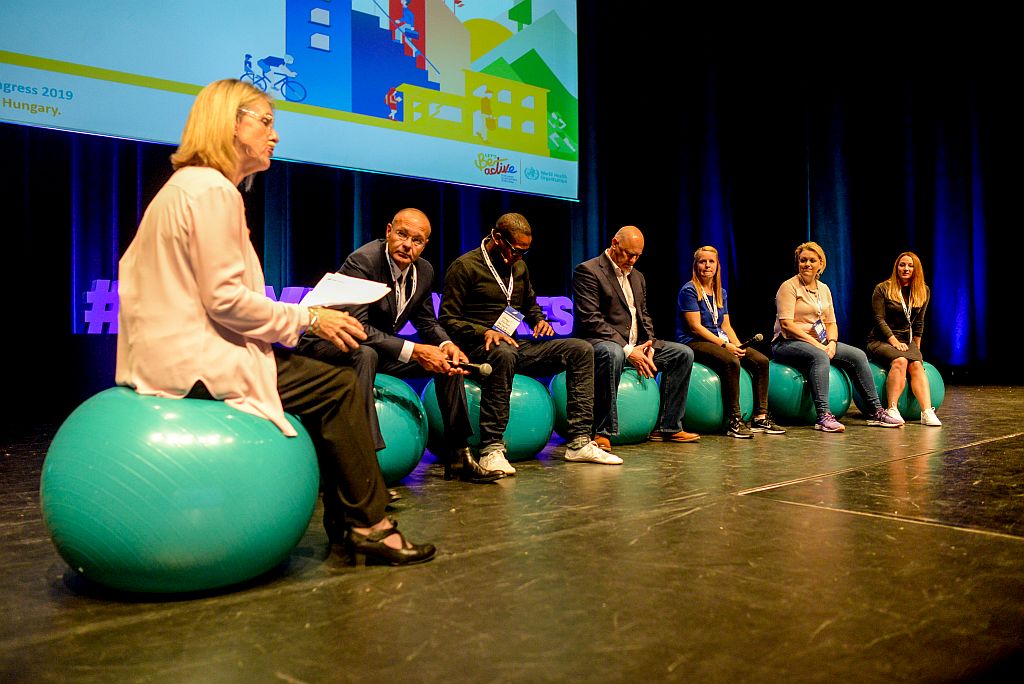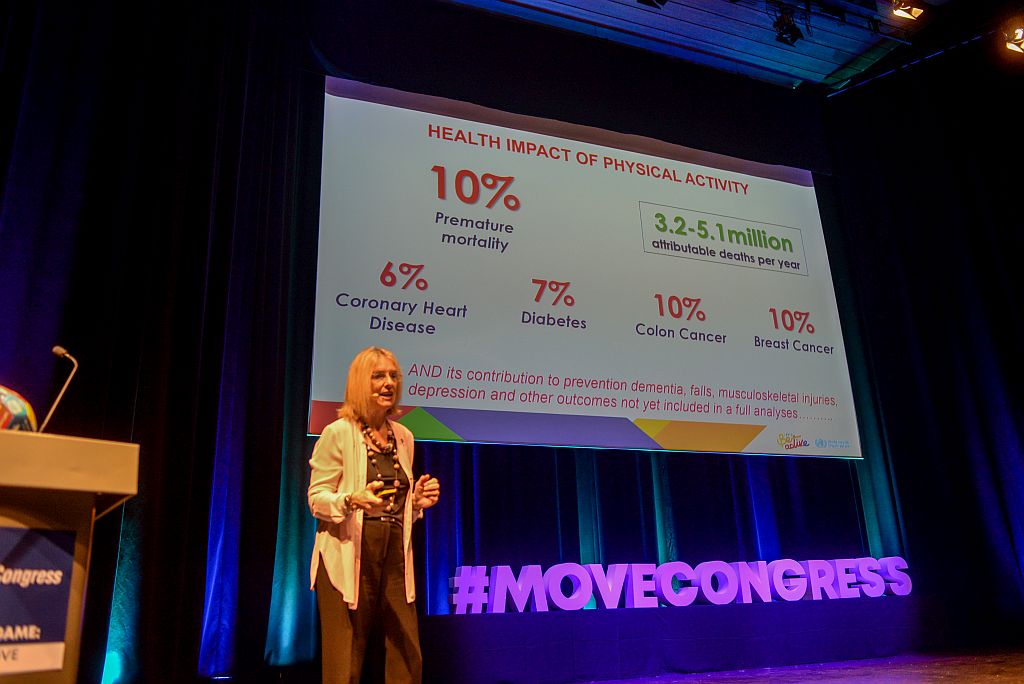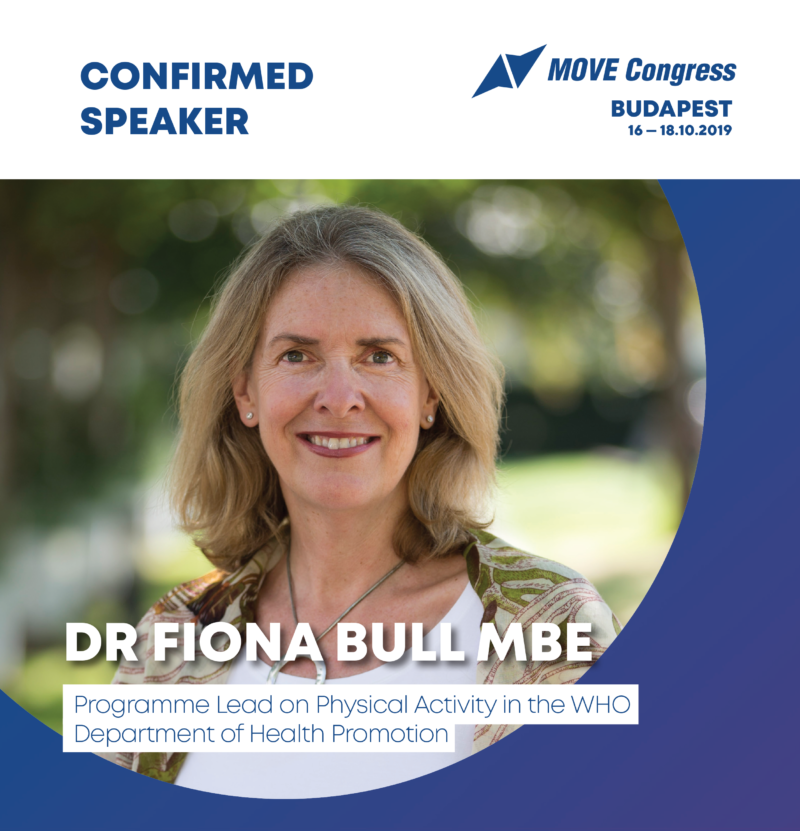Physical activity can help prevent non-communicable diseases. This is an established and scientifically proven fact. But it has taken time for the health and sport and physical activity sectors to recognise that they can join forces to help people become more active for their health. With Dr Fiona Bull from the World Health Organization underlining in the plenary that all MOVE Congress participants could play a part in delivering the WHO’s Global Action Plan for Physical Activity, the question that followed in the parallel track “Game-changers connecting physical activity” was “who are some of the key actors who can help deliver this plan? And what are some game-changing approaches that work?
Moderated by Fiona Bull, Programme Lead on Physical Activity in the Department of Health Promotion at the World Health Organization, the track gathered speakers from the health, fitness, education, technology and sport sectors. The first part of the track took a closer look at the idea of exercise being medicine and prescribing physical activity as part of health care.
“Exercise is medicine. 30 minutes of physical activity per day can replace 10 different drugs,” said Miklós Tóth, president of the Hungarian Society of Sports Science, a widely cited researcher and author of 324 scientific publications in cardiovascular medicine. “That’s why medical professionals should starting prescribing physical activity. This is so-called lifestyle medicine.”
Does this approach really work in practice? Does the prescription of physical activity take place on a regular basis in the health care systems in your countries? This question was addressed to the auditorium and several positive examples followed. Sweden looks to be a true leader in terms of usage of “physical activity as a medicine” by health care professionals, and Denmark, Slovenia, UK, Croatia are also exemplary in this field.
“It shows that it is possible, it is just not happening widely yet,” summed up Fiona Bull.
The importance of movement for cronic disease prevention and therapy was further emphasised in the presentation of the next speaker Darryl Edwards, movement coach, physical activity researcher, author and thought leader in the area of creativity and innovation in fitness and health.
Darryl is the founder of the Primal Play Method. “Wake up your inner child and let’s play it out,” he exclaimed, inviting the participants to try out the innovative approach in a format of fun exercise. Primal Play puts the focus on functional movement that can be adapted in an entertaining way for all ages and abilities.
Gamficiation was also highlighted as a potential game-changer for physical activity promotion in Markos Kern’s plenary speech. So can new technologies get people to move more and sit less? This was the question addressed by Jacqueline Mair, Lecturer in Exercise Physiology at the Edinburgh Napier University, in the next presentation.
“Nowadays 85% of EU adults own a smartphone and 97% of EU adults have access to the internet. We have an opportunity to use technology better understand and improve physical activity at an individual level all the way through to a population level,” she underlined, mentioning a few successful examples.
In the panel discussion that followed the three abovementioned speakers were joined on the stage by Kate Dale, Lead of This Girl Can Campaign, Dr. Paul Bedford, Researcher, Presenter and Fitness Industry Expert, Retention Guru Ltd and Lucie Vickers, National Volunteer and Youth Action Manager representing StreetGames organisation.
Joining the dots – from a physical activity perspective
So what is the most effective way to connect the dots between health and physical activity sectors and work together towards a healthier society?
“We should combine all components and follow the best examples to achieve our common vision: healthy lives and well-being for all at all ages in all countries,” summarised Fiona Bull as the the driving force of the track.
Kate Dale, Paul Bedford and Lucie Vickers took to the stage in the second part of the track, highlighting practical examples of attracting and retaining hard-to-reach groups in physical activity for the benefit of their health.
Sport England’s This Girl Can campaign is a successful example of tackling barriers to women and girls’ participation by showing positive, real life examples of women who play sport and get active regardless of their body shape and social background.
“You can’t be what you can’t see,” is the message the campaign conveys by taking away glossy images of women being active, adopting a “no Photoshop” rule and making empowering statements that embrace reality as a good thing.
The campaign has been rolled out in Australia and spun off into a new Fit Got Real campaign in the UK. The secret to its success, Dale said, was “talking to people, not making assumptions and understanding how they are really feeling.”
This is also at the core of StreetGames approach, as presented by Lucie Vickers, who explained how the charity’s Doorstep Sport approach to delivering sport and physical activities “at the right place and the right time” is an essential method to reach out to communities with customised approaches at their doorsteps. StreetGames’ European Youth Health Champions project successfully joined the dots between the UK Royal Society for Public Health and grassroots sport providers around Europe to train young mentors to deliver positive health messages.
Attracting and retaining members is a big challenge for sport clubs with a more traditional approach. “Retention Guru” Paul Bedford listed 10 influencing factors that can be deciding ones for attracting and retaining members in sport clubs or fitness centres: visits, interactions, programming, group exercise, social, goals, contracts, age and contentment – the 9th factor was left as a cliffhanger for the participants to ponder as they rethink their recruitment strategies.
The track concluded with an interactive workshop led by StreetGames to turn all of the participants in the room into “health champions” regardless of whether they worked in sport, physical activity, education, business or health.
By Irina Coreachina and Rachel Payne, ISCA
Game-changers connecting physical activity and health
Physical activity can help prevent non-communicable diseases. This is an established and scientifically proven fact. But it has taken time for the health and sport and physical activity sectors to recognise that they can join forces to help people become more active for their health. With Dr Fiona Bull from the World Health Organization underlining in the plenary that all MOVE Congress participants could play a part in delivering the WHO’s Global Action Plan for Physical Activity, the question that
Push the boundaries, think younger and embrace change to get more people moving
Dr Fiona Bull from the World Health Organisation (WHO) and Markos Aristides Kern from Fun With Balls commanded the stage in the MOVE Congress plenary on 17 October with TEDx style charisma, zooming in on physical activity from two vastly different angles and reaching one surprisingly similar conclusion. That we need to seriously challenge ourselves when it comes to getting more people active. Challenge ourselves to reach people who are inactive and likely to fall outside the radar of our daily
2 months to go – don’t miss our strongest speaker line-up yet!
With 2 months to go until the MOVE Congress in Budapest, ISCA is delighted to announce that Dr Fiona Bull MBE, from the World Health Organization, will be our first keynote speaker on 17 October and set the scene for one of our strongest conference programmes yet. Following the keynote session, featuring gamification experts Markos Aristides Kern and Rocket Beans TV active storyteller Gino Singh, Dr Bull will lead Track 1 of the MOVE Congress ‘Game-changers connecting physical activity and health’. Kate



